A History of Egyptian Tarot Decks
http://www.spiritone.com/~filipas/Masquerade/Reviews/historye.html
In 1781, the French author Court de Gébelin referred to the Tarot as a book preserving the pure wisdom of ancient Egypt. This is the first written suggestion that occult wisdom had been encoded in the cards - in spite of the fact that they had already been in use for over 300 years.
It was soon thereafter that Tarot decks claiming Egyptian origins would be published. The first of many was a 1789 deck(1) by the French astrologer and cartomancier Etteilla, who called his cards The Book of Thoth(2). These early designs are sometimes referred to as Etteilla I; one version of this pattern is still produced today by Grimaud under the name Grand Etteilla, or Egyptian Gypsies Tarot (shown below). Subsequent designs which altered the symbolism of certain Trumps are referred to as Etteilla II. A third variation, referred to as Etteilla III (shown below), was first produced in 1865 with larger, more ornate imagery.
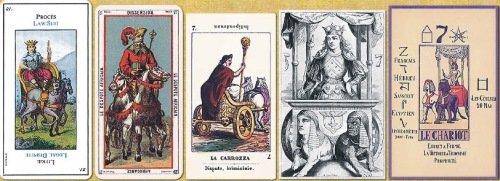
From left to right, the Chariot cards shown above are from: 1. Etteilla I pattern, Egyptian Gypsies Tarot, modern reprint by Grimaud in 1982; 2. Etteilla III pattern, Grand Jeu de Oracle des Dames, designed in 1865 by G. Regamey, reprinted as Tarot Egyptien by Éditions Dusserre in 1985; 3. 1843 Etteilla pattern, Jeu de la Princesse Tarot, reprinted as Cartomanzia Italiana by Edizioni del Solleone in 1983; 4. Lévi's own illustration of Trump VII, Dogme et rituel de la haute magie, 1856; 5. 78 Tarot designs by Jean-Gabriel Goulinat from Papus' 1909 work Le Tarot Divinatoire, reprinted as a deck titled Le Tarot Divinatoire by Éditions Dusserre in 1992.
One early departure from the Etteilla decks was the jeu de la Princesse Tarot(3) (shown above). First published as book illustrations in 1843, the designs attempted a more Egyptian setting than previous decks to emphasize their supposed origins. The cards were numbered consecutively from 1 to 78, following the system started by Etteilla to emphasize that the cards were pages of an ancient book.
But in spite of their titles, these early 'Egyptian' designs were not passed down from ancient culture as their authors claimed, nor did they even portray convincing Egyptian iconography. The science of Egyptology was very young: the Rossetta stone would not be discovered until 1799. The early Etteilla decks are nonetheless interesting, especially because they incorporated symbology from such sources as Genesis and the Hermetic creation myths of The Divine Pymander.
1863 marks the next major notch in the Egyptian Tarot timeline: the publication of a book titled L'homme rouge des Toileries (Red Man of the Tuileries) by a French author writing under the pen name of Paul Christian. This work tells of an encounter between Napoleon and a Benedictine monk who possesses an occult manuscript(4). This manuscript described in detail seventy-eight symbolic houses or pictorial keys, corresponding to the Tarot deck but using Egyptian names and imagery. Virtually the same descriptions of the Arcana would reappear in Christian's later work Histoire de la magie in 1870. Christian's presentation of the Tarot is filled with fictitious history, but his stories were taking hold during this time of growing European interest in all things ancient and occult.
We might surmise whether Christian conceived these descriptions himself, or if he fabricated his fictitious histories as an excuse to document the ideas circulating in the occult circles of his time. There are certainly some details in his book which can be found earlier in the writings of his contemporary: Éliphas Lévi. Lévi's own drawing (shown above) of The Chariot, for example, was the first to replace the horses with sphinxes - a detail repeated by Christian. In any case, much of Christian's elaborate symbolism would find its way into the occult decks that were soon to follow, including those by Falconnier, Papus, Wirth, and even Waite.
Perhaps the watershed event for the Egyptian pattern was the 1896 publication of the book Les XXII lames hermètiques du tarot divinatoire by R. Falconnier. Here, for the first time, could be seen designs which truly mimicked Egyptian art. The images (shown below) were drawn by M.O.Wegener and based on the detailed descriptions by Christian. Readers were encouraged to cut the 22 designs out of the book for use with the divinatory instructions provided. The 56 suit cards were not a part of this divination process, so they were not included in the book.
Tarot historians place the Etteilla decks within the Egyptian Tarot tradition. But it is the designs of Falconnier and Wegener - more authentically Egyptian and based squarely on French occult theory - which mark the birth of the Egyptian Tarot as we think of it today. Although there is no historical basis to claims of Egyptian origin, there is something compelling to the symbolism of these decks.
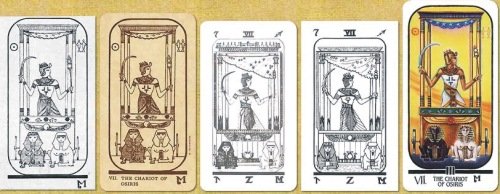
From left to right, the Chariot cards shown above are from: 1. Falconnier and Wegener, Les XXII lames hermètiques du tarot divinatoire, 1896; 2. Egyptian Tarot, 1978 deck by AGMüller based on the 1901 illustrations from Practical Astrology; 3. The Brotherhood of Light Tarot, 1936 illustrations from The Sacred Tarot; 4. The Zain designs were redrawn for the 1996 edition of The Sacred Tarot; 5. The Ibis Tarot by Josef Machynka, published by AGMüller in 1991.
In 1901, just five years after the Falconnier-Wegener publication, Edgar de Valcourt-Vermont published his book Practical Astrology under the pseudonym of Comte C. de Saint Germain. His book reproduced the earlier illustrations of Wegener, and added designs for the Minor Arcana. The only difference between the Wegener designs and the Valcourt-Vermont reproductions is that Trump II (The Gate of the Sanctuary) was slightly redesigned. These 78 images were later published as a deck in 1978 by AGMüller under the name Egyptian Tarot.
The pattern was redrawn in 1936 by Gloria Beresford(5) to illustrate C.C.Zain's(6) book The Sacred Tarot. This version (shown above) added numerous small details, such as the constellations that appear throughout the deck and the miniature drawings added to many designs. The deck was published by the Church of Light under the name Egyptian Tarot Cards, also known as The Brotherhood of Light Tarot which takes its name from the organization which Zain founded. The material in Zain's book was first published by him in 1918 as a series of instructional courses, and was at that time illustrated with the reproductions from Practical Astrology. A new edition of The Sacred Tarot was published in 1996 with significantly improved Tarot designs which are beautifully redrawn (shown above).
Zain's book is especially noteworthy because it included what is likely the first English translation of Christian's original Arcana descriptions. The passages were translated in 1901 by Zain's friend Genevieve Stebbins, to whom he gives credit.
John H. Dequer published a deck in 1949(7) with Trump designs based on those by Zain. Dequer's Egyptian version of The Empress appeared as the cover of Crowley's The Book of Thoth in 1944(8).
Another early appearance of the Egyptian pattern is found in a 1931 book by Woldemar von Uxkull, titled Die Einweihung im alten Ägypten. These designs were the basis of a 1949 deck titled Schikowski Tarot(9) as well as a 1954 deck which accompanied the book Tarot der Eingeweihten by Joachim Winkelmann.
There are several modern decks which follow the Wegener pattern. The Ibis Tarot (shown above), published in 1991 by AGMüller, is one of the most beautiful interpretations of the pattern. It is also one of the most faithful, even though it was painted almost 100 years after the original designs were first published. The artist Josef Machynka actually based his cards on the designs in Practical Astrology, unaware that they were taken directly from the earlier designs of Wegener.
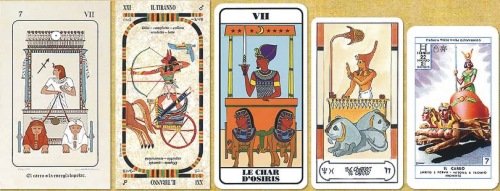
From left to right, the Chariot cards shown above are from: 1. Egyptian Tarots by Silvana Alasia, published in 1996 by Lo Scarabeo; 2. Tarots of the Sphinx by Silvana Alasia, 1998 Lo Scarabeo; 3. Tarocchi di Nefertari by Silvana Alasia, 1998 Lo Scarabeo; 4. Egipcios Kier Tarot, published in the 1970s by Editorial Kier, reprinted in 1984 by U.S.Games Systems; 5. Divinatory Egyptian Tarot, designed by Margarita Arnal Moscardo and published in 1988 by Naipes Comas.
The Italian artist Silvana Alasia has created several Egyptian decks, all published by Lo Scarabeo. The earliest of these was her 1996 Egyptian Tarots (shown above), featuring 78 designs hand painted onto parchment. Her Trumps follow the Wegener pattern, with the exception of cards XII, XIII, XIX, and XX which are based on Egyptian art. In 1998 she created the Tarots of the Sphinx (shown above) which is primarily based upon actual Egyptian imagery. A deluxe version of the deck was simultaneously published as the Tarocchi di Nefertari (shown above), using gold foil stamped onto the backgrounds and text. The designs of the two decks are "mirror images" of each other, but are otherwise identical.
An interesting variation of the Wegener pattern was introduced in the Egipcios Kier Tarot, published by Editorial Kier of Buenos Aires in the 1970's. The deck's designer was an employee of Editorial Kier but his identity is unknown. An English version of this deck (shown above) was printed by U.S.Games Systems in 1984. Many of these Trumps follow the Wegener pattern while others are completely redesigned according to authentic Egyptian sources.
This was the first Egyptian deck to bring fully illustrated scenes and characters into the Minor Arcana. These are inspired by Egyptian sources, and used by the deck designer to symbolize such concepts as Meditation, Cooperation and Rivalry. This was also the first Egyptian Tarot deck to completely remove all suit delineations; all 78 cards are instead numbered in sequence, beginning with The Magician (1) and ending with Rebirth (78).
The Egipcios Kier Tarot pattern spawned numerous decks, many of these published in Spain and South America. One such deck is the Divinatory Egyptian Tarot (shown above), designed by Margarita Arnal Moscardo and published in 1988 by Naipes Comas, Barcelona. Each card represents concepts that are analogous to those of the Egipcios Kier, but the artist has used entirely different designs to do so. The artwork is also taken from actual Egyptian sources.
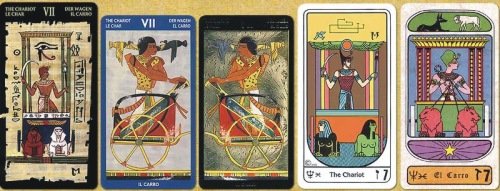
From left to right, the Chariot cards shown above are from: 1. Eulogy to the Book of Thoth, serigraphs published in 1980 by Editorial Barath, Madrid; 2. I Tarocchi Egiziani, published in 1995 by De Vecchi Editore, Italy; 3. Le Tarot des grands initiés de l'ancienne Égypte, Jean-Louis Victor and Geneviève Monat, published in 1994 by Editions de Montagne; 4. Egyptian Tarot, designed by Esther Casla and published by Heraclio Fournier, Spain; 5. Il Destino Svelato dal Tarocco, originally designed by Bruno Sigon in 1912, reprinted in the 1970s by Modiano.
The watercolor designs of the Egyptian Tarot (shown above) were published by Heraclio Fournier. It's designs reflect the same concepts found in the Egipcios Kier pattern, yet like the Divinatory Egyptian Tarot it reinterprets these ideas with slight nuances. Card 35, for example, is Desolation in the Egipcios Kier, Pain in the Divinatory Egyptian Tarot, and Sadness in the Fournier Egyptian Tarot, Card 58 is Meditation, Prevention, and Reflection respectively; Card 71 is Avarice, Conservation, and Greed respectively.
The Spanish artist Suarez designed 22 beautiful Arcana images (shown above) to accompany poetic verses written by Victorino del Pozo in 1980. The designs were silk-screened onto large sheets and published by Editorial Barath as a limited edition of 999 sets. The prints and poem are titled Eulogy to the Book of Thoth, although it is sometimes referred to as the Barath Egyptian Tarot.
Laura Tuan designed a 78-card deck called I Tarocchi Egiziani or The Egyptian Tarot (shown above), published in 1995 by De Vecchi Editore. The Major Arcana are based exclusively on Egyptian imagery generally corresponding to the Trumps. The deck retains the traditional Tarot structure of 22 Major and 56 suit cards, although the Trumps do not follow their traditional sequence. The Minor cards show arrangements of the suit symbols, which take the form of djed staves, lotus chalices, Egyptian daggers, and scarab coins. This is a nice example of a deck which uses true Egyptian iconography without abandoning a Tarot structure.
Il Destino Svelato dal Tarocco (shown above) is a stylized Egyptian Tarot deck originally painted by Bruno Sigon in 1912. Its 56 suit cards are distinct from the Trumps - they are not by Sigon but were taken straight from a Milanese pattern.
Modiano, the original publisher, reprinted this deck in the 1970s under the title Cartomanzia 184, as well as an English version in 1981 under the title Cagliostro Tarot. Interpretive keywords are printed at the top and bottom of every card. Those for the 22 Trumps are noteworthy because they come from the work of Éliphas Lévi and Paul Christian(10).
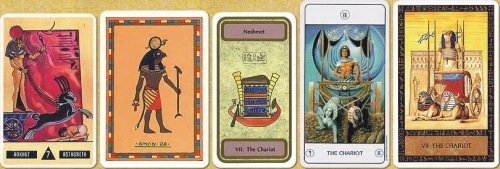
From left to right, the cards shown above are from: 1. The Book of Doors, designed in 1986 by Athon Veggi and Alison Davidson, published in 1995 by Destiny Books; 2. Ishbel's Temple of Isis Egyptian Tarot, designed by Ishbel and published in 1989 by Llewellyn; 3. Tarot of Transition, published in 1983 by Carta Mundi. 4. Tarot of the Ages, 5. The Ancient Egyptian Tarot, illustrated by Clive Barrett and published in 1994 by Thorsons.
Some decks explore the Egyptian mythos by abandoning the Tarot structure altogether. The Book of Doors (shown above) does this with 64 beautifully painted cards depicting Egyptian deities. The designs were created in 1986 by Athon Veggi and Alison Davidson, and published by Destiny Books in 1995. The Book of Doors is truly representative of the mythology and iconography of ancient Egypt.
Ishbel's Temple of Isis Egyptian Tarot (shown above) was designed by Ishbel and published in 1989 by Llewellyn. It retains a traditional Tarot structure, but the Major Arcana designs are replaced with various Egyptian deities. The artwork is colorful but simplistic, with each deity placed against a golden yellow background with no other symbols or scenery. The Minor Arcana cards show arrangements of the suit symbols: Shepherds Crooks, Flail, Sebas (Solar cross), and Lotus Flowers.
The Tarot of Transition (shown above) also replaces the traditional Trumps with Egyptian deities and symbolism, but these selections are rather idiosyncratic. The Minor Arcana cards display arrangements of the suit symbols. The deck was published in 1983 by Carta Mundi.
Several multi-cultural decks incorporated Egyptian mythology. The Ancestral Path Tarot and the Kazanlar Tarot, for example, both devote one suit to Egyptian scenes. The Tarot of the Ages (shown above) incorporates several ancient cultures into its art, but its Major Arcana is primarily Egyptian.
Unlike the two-dimensional designs of most Egyptian decks, the beautiful paintings by Clive Barrett stand out because of their realistic style. The Ancient Egyptian Tarot (shown above) is a traditional 78-card deck with fully illustrated Major and Minor Arcana. Barrett's designs have an underlying connection with the teachings of the Order of the Golden Dawn, but his images have little similarity to the Waite-Smith and Crowley-Harris decks. Barrett's symbolism is also well-researched; he even authored a separate study of the Egyptian pantheon titled The Egyptian Gods & Goddesses: The Mythology & Beliefs of Ancient Egypt. The Ancient Egyptian Tarot was published in 1994 by Thorsons as a book and deck set.
Tracing the evolution of the Egyptian decks helps us understand the origins of the occult Tarot. But this overview is by no means exhaustive; hundreds of such decks have been published, and hundreds more have been influenced by this lineage.
Review by Mark Filipas, 3/1/01
(1) Decker, Depaulis and Dummettt, A Wicked Pack of Cards, pp.91-92
(2) This pseudonym for the Tarot first appeared in an earlier essay by comte de Mellet, which was included in Gébelin's book of 1781.
(3) Also known as the grand jeu de tarots égyptien; see also Decker, Depaulis and Dummettt, A Wicked Pack of Cards, p.150.
(4) A fuller summary can be found in A Wicked Pack of Cards, p.197-202.
(5) See front of the 1987 edition of The Sacred Tarot.
(6) Pseudonym of Elbert Benjamine.
(7) See Kaplan's Encyclopedia of Tarot vol. I, p.219
(8) This cover is shown in Kaplan's Encyclopedia of Tarot vol. I, p.354
(9) This deck can be seen in Kaplan's Encyclopedia of Tarot vol. I, p.220
(10) See Levi's Dogma and Ritual of High Magic (Transcendental Magic) and Splendor of Lights; Christian's The History and Practice of Magic.
Images Copyright © their respective publishers, Review Copyright © 2001 Mark Filipas